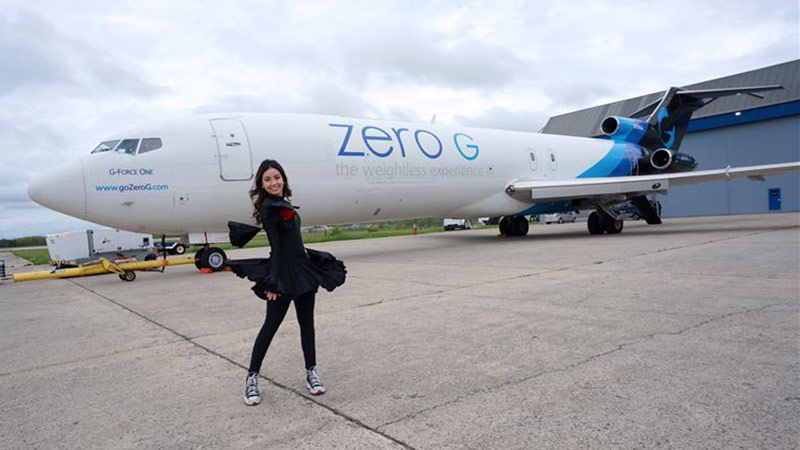Becoming weightless: How one UNB student blended fashion, media, cultural identity and zero gravity
Author: Kayla Cormier
Posted on Nov 1, 2024
Category: UNB Saint John , UNB Fredericton

University of New Brunswick (UNB) student Jagriti Luitel has always had her eyes on the sky.
At a young age, going to space became her life’s mission. Today, in the final year of her undergraduate degree, she is well on her way to achieving that mission. Yet her path has not been linear, nor has it been easy.
In May 2024, Luitel took part in a zero-gravity parabolic flight through the Aurelia Institute. The project began in February, but Luitel said it was the culmination of years of indirect preparation.
Luitel’s project was unique because she approached it with an artistic, interdisciplinary mindset.
“The significance behind the project was very important for me to flesh out,” she said. “I really wanted to take an innovative approach to my participation, with a fusion of art and culture.”
She began by asking herself: “Why does this matter for long-duration space flights? Why does this matter for countries like Nepal (where Jagriti was born), where there is very little space-related representation?”
Luitel took an online leadership course titled SpaceKind, where she met the New York-based fashion designer behind Pisces Rising, Deborah Won, to whom Luitel was immediately drawn.
Won creates spacewear couture: garments designed to enhance movement in zero gravity.
Luitel and Won teamed up, and after countless hours of collaborative blood, sweat and tears, they conceptualized and created the dress that Luitel would wear on the flight.
On the ground, the piece looked black, but when Luitel moved through zero gravity, the garment responded, metamorphized.

As Luitel became weightless, her garment bloomed with vibrant Rhododendrons—Nepal’s beloved national flower.
“The experience was like nothing I’ve ever felt before.”
“I created a place for art and Nepalese cultural identity to be included on the flight,” Luitel said. “Not that art is more important than engineering or other STEM fields, but it was different.”
“The project suggests that as we move into space, we must bring with us the elements that make us human: culture, expressions of identity and our need for individuality and belonging.”
While acknowledging that this experience was once-in-a-lifetime, Luitel also spoke of the imposter syndrome that came with her involvement in the zero-gravity flight.
“Most of the people on that flight were much older and more established in their careers. It was really a research flight, so the whole ecosystem was made up of folks from high-performing space organizations.
“I kept asking myself, ‘Where do I fit in here?’ Questions of belonging definitely have a thread throughout my life story,” she said.
Luitel’s family immigrated to Canada from Nepal in 2017, following the 2015 Nepal earthquake. This was an incredibly difficult time for her family: “quite literally earth shattering,” she said.
Finding her place in Canada came with both beauty and hardship, and it took Luitel lots of internal reflection to figure out where she wanted to be academically.
She began her undergraduate degree in UNB’s department of mechanical engineering in 2020, at the height of the Covid-19 pandemic. She recalled that many of the lab components of the degree were not available because of the pandemic, so she found herself getting restless.
“In engineering, building things is very important. That’s why I was so inspired to do the balloon project,” she said.
Related: UNB engineering students successfully launch weather balloon into near space.
After two years in mechanical engineering, Luitel became a Zenith Fellow and did an internship in Edmonton.
“After the internship, I switched to computer science. I learned that perhaps that was the best way to get access to the aerospace field—the next wave kind of thing.”
“During that year, I got another internship at the Canadian Space Agency,” she said. “I got exposure to so much academia and industry startup research. I saw people working in the field that I was on the path to obtaining.”
But something wasn’t sitting right with Luitel.
“I started questioning if this is what I wanted for myself, if I would be fulfilled from the path I was on,” she said. “Then, after some personal and workplace challenges, I was really forced to reflect on what I wanted.”
“After lots of journalling and introspection, I learned that I’m more of an interdisciplinary person,” she said.
“My goal was the same: I still wanted to go to space, but I just gained the confidence to take a different path there: A path less travelled in the field of aerospace.”
So, Luitel took a leap into UNB’s interdisciplinary Media Arts & Cultures program.
“I love the program. I love the humanities. Human emotions are valued, and there’s high emotional intelligence throughout the department,” she said. “I’m so grateful.”
“It really felt like a ‘have my cake and eat it too moment’,” she laughed. “I could still go to space, but the focus could be different.
Luitel spoke of a shift in the commercialization of the space sector and how that helped her make her decision to shift to an arts program. Formerly, space exploration was the domain of national governments, but now, due to privatizations and technological advancements, non-government astronauts have access to space.
She also credits her experience emigrating from Nepal to Canada for giving her a global perspective and an entrepreneurial mindset.
“I can see myself starting a space TV show. I currently have a podcast and a YouTube channel, and I would like to grow those channels of communication.”
Luitel said she would like to change the perception that aerospace is only for people in STEM fields.
“I’m very passionate about democratizing access to space,” she said.
“Space is an extension of humanity’s journey. It’s a journey into the future. It inspires all of us, not just those in STEM fields, and it’s not just one domain—it intersects with everything.”
She gives agriculture, art, fashion, satellite data, disaster management and manufacturing techniques as examples of ways space is interconnected in our day-to-day lives.
When asked what’s next, Luitel said she’s working part-time with the former premier of New Brunswick, Brian Gallant, at Space Canada, a start-up that combines government, industry and academia to elevate the Canadian aerospace sector. She is also interning with the Aurelia Institute.
“I’m very much in the thinking phase about what I will do post-grad,” she said. “Rest is a big word for me right now.
"But the long-term goal is to go to space.”
Discover Jagriti’s first-hand account of her journey to the zero-gravity flight on her blog.
